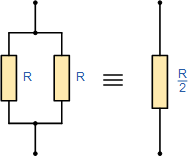Series and parallel
Resistors can be connected in different blends to help make a circuit:Arrangement - Where the resistors are connected consistently.
Parallel - Where the resistors are connected more than each other.
There are a wide range of kinds of resistors. Resistors have distinctive appraisals to tell circuit testers how much power they can deal with before they break and how precisely they can moderate the streaç_im of electricity.Connecting two resistors in arrangement results in a higher opposition than when you interface a similar two resistors in parallel. To keep the resistor from achieving its ability, put the resistors in parallel to keep the aggregate obstruction lower. These days the electrical business much of the time utilizes purported surface-mount innovation based resistors which can be little
Calculating resistance
Series Circuit: Rt=R1+R2+R3+R4...RnParallel Circuit: 1/Rt=1/R1+1/R2+1/R3...1/Rn
Where R is the resistor's value
Serie
Parallel
Ohm’s Law
The formula for Ohm’s law, V=I*R, states that the voltage drop across a component is equal to the product of the current flowing in the component multiplied by the resistance of the component. When using Ohm’s law, you are able to switch the formula around if needed to find a different outcome: I=V/R or R=V/IResistor Color Code
Resistor's qualities are appraised by the hues that are recorded in favor of the resistor. The shaded groups that are utilized on the sides of a resistor are dark, brown, red, orange, yellow, green, blue, purple, dim, and white. Each shading speaks to an alternate number. The dark band speaks to the number 0, darker band speaks to the number 1, red is 2, etc the distance to white which is the number 9. These numbers are imperative in the electronic field.A resistor can have different groups of shading on its side. The most widely recognized have four however they can extend as far as possible up to 6 for each resistor. On a four band resistor, the last band is gold or silver. The gold band speaks to a positive or negative 5% resilience. The silver band on a resistor speaks to a positive or negative 10% resilience. Hold this band on the correct side, and read the hues from left to right. The initial two groups are perused as the numbers that they speak to in the shading code. The third band goes about as a multiplier for alternate groups, so for instance, if the third band was an orange band which is a 3, it would mean you duplicate the two numbers by 1000. In short you include the estimation of the shading in zeros toward the end, so include three zeros.
Online number crunchers are accessible to figure Resistor Color Codes. At the point when the shading codes are submitted to the number cruncher this will naturally compute the obstruction of the resistor, alongside the resilience












